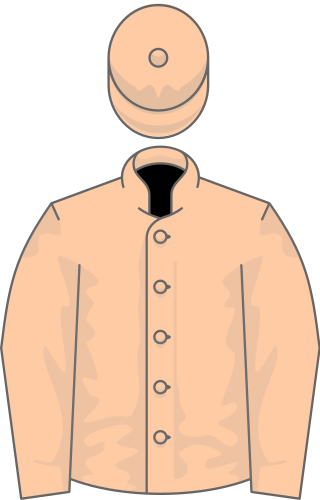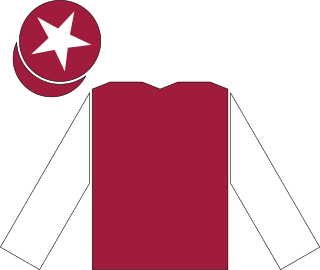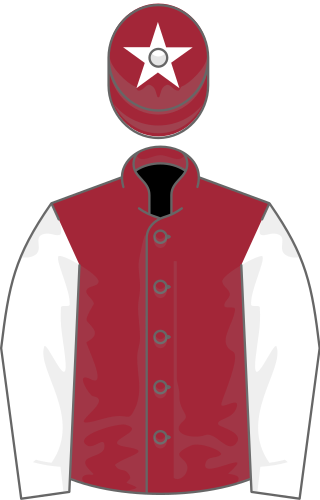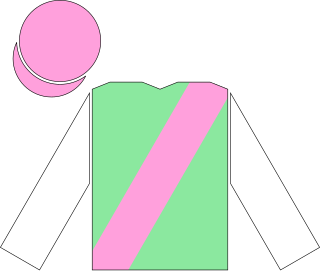
Steve Cauthen is a retired American jockey.

Slip Anchor (1982–2011) was a British Thoroughbred racehorse best known for winning the 1985 Epsom Derby by seven lengths. After showing some promise as a two-year-old, he showed substantial improvement in the spring of 1985, winning the Derby Trial at Lingfield Park Racecourse by ten lengths before recording a rare start-to-finish win in the Derby. He was rated the best racehorse in Europe in 1985. His subsequent career was disrupted by injury, and he finished second in his other three races before being retired to stud. He had some success as a breeding stallion and died in 2011.
The 1987 Epsom Derby was a horse race which took place at Epsom Downs on Wednesday 3 June 1987. It was the 208th running of the Derby, and it was won by the pre-race favourite Reference Point. The winner was ridden by Steve Cauthen and trained by Henry Cecil.

Reference Point was a British Thoroughbred race horse and sire. In a career which lasted from August 1986 to October 1987 he ran ten times and won seven races. As a three-year-old he overcame sinus problems before winning York's Dante Stakes, the Derby, Ascot's King George VI and Queen Elizabeth Diamond Stakes, the Great Voltigeur and St. Leger in 1987. It was not until 2012 that another Derby winner contested the St. Leger; when Camelot attempted, and failed, to win the English Triple Crown. His final race of the season resulted in failure in the Prix de l'Arc de Triomphe at Longchamp, Paris when an abscess was later found to have been responsible for his below-par performance.

Oh So Sharp (1982–2001) was an Irish-bred, British-trained Thoroughbred racehorse best known for winning the English Fillies' Triple Crown in 1985. In a racing career which lasted from August 1984 until September 1985, she won seven of her nine races, starting favourite on each occasion and never at odds of more than 2/1. She was one of the leading two-year-old fillies of 1984 when she was unbeaten in three races, including the Fillies' Mile. In the following year Oh So Sharp won the 1000 Guineas in record time and then took the Oaks by six lengths before being narrowly beaten in her next two starts in major weight-for-age races. The filly completed the Triple Crown in the St Leger Stakes. She was retired at the end of the season and became a successful broodmare. Oh So Sharp died in 2001 at the age of nineteen.
Moon Madness, was a British Thoroughbred racehorse and sire. In a career which lasted from September 1985 until November 1988, he ran twenty-four times and won ten races. He recorded his most important success when winning the Classic St. Leger Stakes as a three-year-old in 1986, the same year in which he also won the King George V Stakes, and the Scottish Derby. He continued to race for the next two seasons in major middle-distance and staying races, with his victories including the Grand Prix de Saint-Cloud, the Geoffrey Freer Stakes the Cumberland Lodge Stakes and the Yorkshire Cup. He later stood as a stallion in Europe and Japan.
The 1985 Epsom Derby was the 206th annual running of the Derby horse race. It took place at Epsom Downs Racecourse on 5 June 1985.
Cormorant Wood was a British Thoroughbred racehorse and broodmare. She showed useful form in the early part of her career but developed into a top-class runner in the second half of her three-year-old season, winning the Sun Chariot Stakes and Champion Stakes at Newmarket Racecourse in October 1983. Her four-year-old season was curtailed by injury, but she became the first filly to win the Lockinge Stakes and produced her best performance in her final race when she won the Benson and Hedges Gold Cup at York Racecourse. At the end of the year she was the highest-rated female racehorse trained in Europe. Cormorant Wood was retired to stud where she had some success as a producer of winners.

Unite was an Irish-bred, British-trained Thoroughbred racehorse and broodmare best known for winning The Oaks in 1987. She finished second in her only race as a two-year-old and won a minor race in the spring of 1987 before winning the Oaks. She followed up with an easy win in the Irish Oaks but was retired from racing after running poorly in the King George VI and Queen Elizabeth Stakes. She had some success as a broodmare.
Celestial Storm was an American-bred, British-trained Thoroughbred racehorse and sire. Although he never won above Group Two level, he was rated among the ten best racehorses in Europe in both 1986 and 1987. As a three-year-old he won the March Stakes and finished second in both the St Leger Stakes and the Champion Stakes. His four-year-old was restricted to two races, a win in the Princess of Wales's Stakes and a second place behind Reference Point in the King George VI and Queen Elizabeth Stakes. Celestial Storm stood as a breeding stallion in the United Kingdom and Japan but had very little success as a sire of winners.
The 1988 King George VI and Queen Elizabeth Stakes was a horse race held at Ascot Racecourse on Saturday 23 July 1988. It was the 38th running of the King George VI and Queen Elizabeth Stakes.

The 1986 King George VI and Queen Elizabeth Stakes was a horse race held at Ascot Racecourse on Saturday 26 July 1986. It was the 36th running of the King George VI and Queen Elizabeth Stakes.
Hawaiian Sound was an American-bred, British-trained Thoroughbred racehorse and sire. In a fifteen-race career he won five times, including the Group One Benson and Hedges Gold Cup in 1978. The horse was also placed in several other top-class races – Royal Lodge Stakes, Chester Vase, the Derby, Irish Derby, King George VI and Queen Elizabeth Stakes and Champion Stakes. His later career was compromised by illness and he was not a success at stud.

Polygamy was a British Thoroughbred racehorse, best known for winning the classic Epsom Oaks in 1974. As a two-year-old in 1973, she showed promise by winning three races and finishing fourth in the Critérium des Pouliches. In the following spring she won the 1000 Guineas Trial Stakes and was narrowly beaten in the 1000 Guineas before winning the Oaks. She was retired after being beaten in her only subsequent race and died without producing a foal.
Sir Harry Lewis was an American-bred Thoroughbred racehorse and sire best known for his win in the 1987 Irish Derby. After finishing second on his only appearance as a two-year-old he won his first two races in 1987 including the Dee Stakes. He finished fourth in The Derby before winning the Irish equivalent, which was then the most valuable race for three-year-olds ever run in Europe. Later that year he was placed in both the Matchmaker International and the Rothman' International. He ran twice in Europe as a four-year-old before being transferred to the United States where he had limited success. Sir Harry Lewis made little impact as a breeding stallion in North America, but made his mark as a sire of jumpers in Europe.
Bint Pasha was an American-bred British-trained Thoroughbred racehorse and broodmare. She showed promise as a juvenile in 1986 when she won once and finished fourth in the Fillies' Mile. In the following year she emerged as a top class performer when moved up in distance, finishing fourth in the Oaks Stakes before winning the Pretty Polly Stakes in Ireland, the Yorkshire Oaks in England and the Prix Vermeille in France. She failed to win in three starts in 1988 and was retired from racing. She had some success as a broodmare, producing at least eight winners.
Saint Estephe was a French Thoroughbred racehorse and sire. Unraced as a juvenile he proved himself to be a high-class middle-distance performer in 1985 when he won the Prix Maurice de Nieuil and was placed in the Prix Hocquart, Prix du Lys, Prix Niel and Prix du Conseil de Paris. In the following year he was better than ever, winning the Prix d'Harcourt and finishing third in the Prix Ganay before recording his greatest success in the Coronation Cup. He went on to finish second in the Grand Prix de Saint-Cloud and the Prix du Prince d'Orange before sustaining an injury in the Prix de l'Arc de Triomphe. He was retired to stud in France and had some success as a breeding stallion before dying at the age of sixteen in 1998.
Shady Heights was a British Thoroughbred racehorse. In four seasons on the racecourse he competed in Britain, Ireland, France, Germany, Japan and the United States, winning seven of his twenty-nine contests.
Eurobird was an Irish Thoroughbred racehorse and broodmare. A specialist stayer who was well-suited by soft or heavy ground, she was the third Classic race winner produced by the broodmare Irish Bird. As a three-year-old in 1987 she made steady improvement, winning the Kinderhill Oaks Trial, Blandford Stakes and Irish St. Leger by wide margins as well as finishing third in the Irish Oaks. At the end of the year she was rated the best filly in Europe over fourteen furlongs and further. She failed to win as a four-year-old but ran several good races in defeat. She later had considerable success as a broodmare, being the dam of at least ten winners.
Risk Me was a French-bred British-trained Thoroughbred racehorse and sire. As a juvenile in 1986 he won his first two races including the National Stakes and later finished second in both the Middle Park Stakes and the Prix de la Forêt.His performance in the latter race saw him rated the best two-year-old colt to race in France that year. In the following year he won the Greenham Stakes in England but had his biggest success in France where he won the Prix Jean Prat and the Grand Prix de Paris. He failed to win again and was retired from racing at the end of the year. He had modest success as a breeding stallion.







